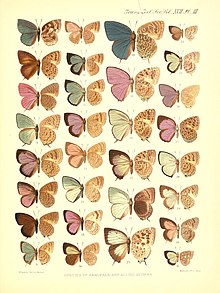| Arhopala hesba | |
|---|---|

| |
| Arhopala hesba in Bethune Baker (figure 28) | |
|
Scientific classification
| |
| Domain: | Eukaryota |
| Kingdom: | Animalia |
| Phylum: | Arthropoda |
| Class: | Insecta |
| Order: | Lepidoptera |
| Family: | Lycaenidae |
| Genus: | Arhopala |
| Species: | A. hesba
|
| Binomial name | |
| Arhopala hesba | |
Arhopala hesba is a butterfly in the family Lycaenidae. It was described by William Chapman Hewitson in 1869. It is found in the Indomalayan realm where it is endemic to the Philippines. [2]
Description
The male is above lustrous sky-blue, not violet as the preceding species [ agesias ] and with a black margin of 1.5 to 2 mm. Beneath the dark sepia-coloured spots are very conspicuous in the light red-brown ground-colour. The female is above similar to the male but the wings do not exhibit the bright Morpho lustre of the males. [3]
References
- ^ Hewitson , W.C. 1863–1878. Illustrations of diurnal Lepidoptera, Lycaenidae. London, van Vorst, x + 229 pp, 107 pls.
- ^ Seitz, A., 1912-1927. Die Indo-Australien Tagfalter Grossschmetterlinge Erde 9
-
^ Seitz , A. Band 9: Abt. 2, Die exotischen Großschmetterlinge, Die indo-australischen Tagfalter, 1927, 1197 Seiten 177 Tafeln
 This article incorporates text from this source, which is in the
public domain.
This article incorporates text from this source, which is in the
public domain.
External links
- Arhopala Boisduval, 1832 at Markku Savela's Lepidoptera and Some Other Life Forms. Retrieved June 3, 2017.
| Arhopala hesba | |
|---|---|

| |
| Arhopala hesba in Bethune Baker (figure 28) | |
|
Scientific classification
| |
| Domain: | Eukaryota |
| Kingdom: | Animalia |
| Phylum: | Arthropoda |
| Class: | Insecta |
| Order: | Lepidoptera |
| Family: | Lycaenidae |
| Genus: | Arhopala |
| Species: | A. hesba
|
| Binomial name | |
| Arhopala hesba | |
Arhopala hesba is a butterfly in the family Lycaenidae. It was described by William Chapman Hewitson in 1869. It is found in the Indomalayan realm where it is endemic to the Philippines. [2]
Description
The male is above lustrous sky-blue, not violet as the preceding species [ agesias ] and with a black margin of 1.5 to 2 mm. Beneath the dark sepia-coloured spots are very conspicuous in the light red-brown ground-colour. The female is above similar to the male but the wings do not exhibit the bright Morpho lustre of the males. [3]
References
- ^ Hewitson , W.C. 1863–1878. Illustrations of diurnal Lepidoptera, Lycaenidae. London, van Vorst, x + 229 pp, 107 pls.
- ^ Seitz, A., 1912-1927. Die Indo-Australien Tagfalter Grossschmetterlinge Erde 9
-
^ Seitz , A. Band 9: Abt. 2, Die exotischen Großschmetterlinge, Die indo-australischen Tagfalter, 1927, 1197 Seiten 177 Tafeln
 This article incorporates text from this source, which is in the
public domain.
This article incorporates text from this source, which is in the
public domain.
External links
- Arhopala Boisduval, 1832 at Markku Savela's Lepidoptera and Some Other Life Forms. Retrieved June 3, 2017.